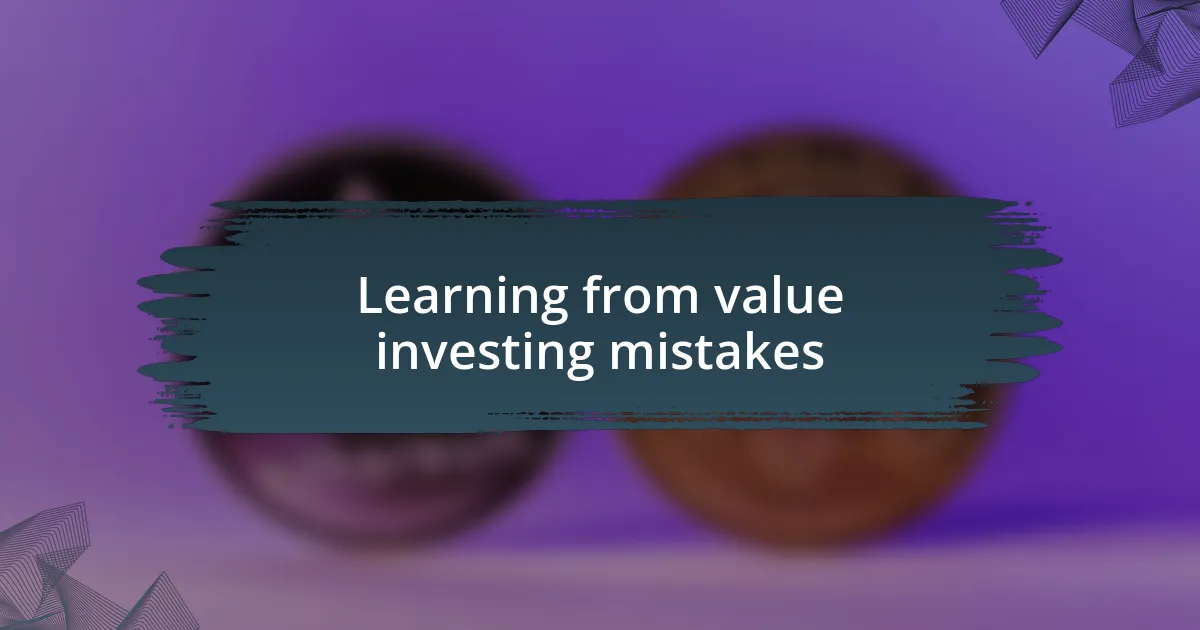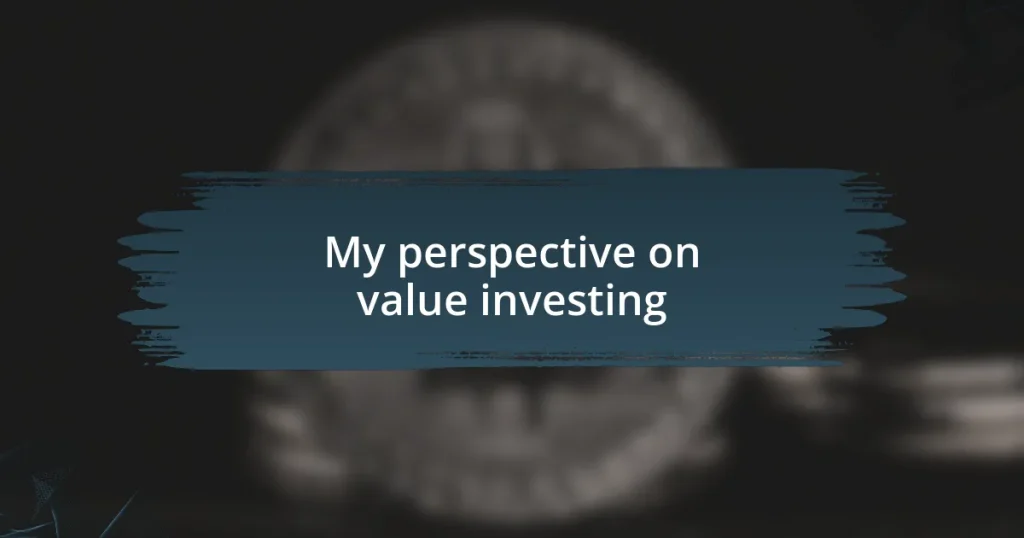Key takeaways:
- Value investing involves buying undervalued stocks and requires thorough research, a margin of safety, and patience for long-term gains.
- Identifying undervalued stocks relies on analyzing key financial indicators like P/E ratio, cash flow, and market trends.
- A diversified portfolio across different asset classes and geographic locations minimizes risks and enhances growth potential.
- Learning from past mistakes, such as emotional biases and lack of diversification, is crucial for successful investing strategies over time.

Understanding value investing principles
Value investing centers on the idea of buying undervalued stocks and holding them until their true worth is recognized by the market. I remember my first experience with this approach; I hesitated before investing in a company that I believed was solid but overlooked. It turned out to be a pivotal decision, teaching me how patience can pay off.
At its core, the principle of value investing relies on thorough research to uncover hidden gems. Have you ever stumbled upon a book you felt was undervalued, only to find it resonated deeply with you? That’s how I see value investing—it’s about recognizing potential in places where others may not be looking.
Another key principle is margin of safety, which protects against unforeseen risks. I find comfort in this idea; it’s like wearing a seatbelt while driving. Knowing that I’ve provided myself with a buffer allows me to invest with confidence, even when market fluctuations occur. This mindset has proven crucial in navigating the sometimes turbulent waters of investing.

Identifying undervalued stocks
Identifying undervalued stocks requires a keen eye for detail and a willingness to dig deep into financials. I recall a time when I came across a company with promising earnings growth, yet its stock price lagged due to temporary market fears. That experience taught me the importance of looking beyond surface-level sentiments and understanding the underlying business fundamentals.
To spot these hidden opportunities, I focus on several key indicators:
- Price-to-Earnings (P/E) ratio: A lower ratio compared to industry peers may suggest undervaluation.
- Book Value: Assessing the company’s assets versus its liabilities can reveal its true worth.
- Cash Flow Statements: Positive cash flow can be a sign of a stable business that is undervalued.
- Market Trends: Keeping an eye on broader market sentiment can help identify stocks that are being overlooked.
- Growth Potential: Companies with strong growth prospects that aren’t reflected in their current stock price can be prime candidates for value investment.
Being mindful of these factors has enhanced my ability to identify stocks that could deliver substantial returns over time.

Evaluating company fundamentals
When evaluating company fundamentals, it’s essential to dive deeper than just numbers. I remember analyzing a small tech firm whose balance sheet displayed manageable debt levels but alluded to explosive growth in an emerging market. This revelation felt exhilarating, sparking the realization that understanding the broader context of financials could lead to incredible investment opportunities.
Cash flow statements are particularly telling. I once encountered a company with stellar earnings reports but consistently negative cash flows. At first, I was skeptical about its future, leading me to pass on it. Later, I learned that even strong earnings can be misleading if they are not supported by solid cash flow, reinforcing the importance of a comprehensive evaluation.
Lastly, I often reflect on the role of qualitative factors—like management competence and market positioning—when analyzing fundamentals. These elements can influence a company’s potential as much as the quantitative metrics. For instance, I invested in a firm with a strong, visionary leadership team; their strategic direction was evident in their robust market adaptation during challenging times. That experience taught me to appreciate the narrative behind the numbers.
| Fundamental Aspect | Importance |
|---|---|
| Cash Flow | Indicates financial health and operational efficiency |
| Debt Levels | Shows financial stability and risk potential |
| Management Quality | Impacts strategic direction and company resilience |
| Market Position | Reflects competitive advantage and future growth opportunities |

Analyzing market trends and risks
Analyzing market trends requires a keen eye for the subtle shifts that can indicate both opportunity and risk. I once monitored a sudden surge in the renewable energy sector. At first glance, it felt like an obvious investment, but digging deeper revealed fluctuating policy support and supply chain vulnerabilities that could disrupt the momentum. This experience sparked my curiosity about how macroeconomic factors and government regulations shape market dynamics.
Risks in the market can often stem from broader economic conditions, which are sometimes unpredictable. I remember experiencing a downturn during a global crisis, watching a previously thriving industry crumble. It taught me that diversifying investments and staying informed about geopolitical tensions are crucial for safeguarding one’s portfolio against unexpected shocks.
In addition to external risks, I’ve also learned the importance of recognizing the impacts of market sentiment. I invested in a well-respected pharmaceutical company, yet became wary when I noticed a drastic negative shift in public perception over a product recall. This situation underscored for me how quickly market psychology can alter a company’s prospects, sometimes disregarding solid fundamentals. It raised a question: how can investors balance emotional reactions with rational analysis? For me, the answer lies in ongoing education and reflection on both the numbers and the narratives shaping the market.

Building a diversified portfolio
Building a diversified portfolio is one of the most effective strategies in investing. I vividly remember when I started my journey; I put all my savings into one promising tech stock. While the initial gains were exhilarating, I realized how quickly fortunes can change in that sector after a sudden earnings miss. This taught me the hard way that spreading investments across various sectors can cushion the blow of unexpected downturns.
When I think about diversification, I often reflect on the balance between different asset classes. In my experience, having a mix of stocks, bonds, and real estate has not only minimized risks but also opened up avenues for consistent growth. For instance, during a stock market slump, my bond investments gave me peace of mind and stability, reminding me that not all investments need to be tied to the same risk levels.
I also believe that location matters in diversification. Investing in international markets can offer exposure to growing economies that aren’t subject to the same political climates or economic cycles as one’s home country. I personally ventured into emerging markets and was both nervous and excited. Ultimately, the reward was enriching, providing a layer of safety and opportunity that helped my overall portfolio thrive. Isn’t it interesting how diversifying geographically can not only enhance returns but also broaden your perspective as an investor?

Long term strategies for success
Long-term investing is all about patience and perspective. When I first started, I often found myself checking stock prices daily, which created unnecessary anxiety. It wasn’t until I adopted a long-term mindset that I felt liberated. I began to think of my investments as a journey rather than a sprint. This change in attitude not only reduced my stress but also allowed me to focus on the fundamentals of the companies I invested in.
Another key strategy I’ve found invaluable is consistently adding to my investments, regardless of market conditions. I remember making additional contributions every month, even during downturns. It felt daunting to invest when everything was in the red, but I learned that this approach, known as dollar-cost averaging, can smooth out the volatility. It’s like watering your garden; the more you nurture it consistently over time, the more it flourishes.
Lastly, I can’t stress enough the importance of reviewing and adjusting your portfolio periodically. In my own experience, I’ve found that keeping an eye on the relevance of my investments in the context of changing market conditions is crucial. I once overlooked a slowing sector and felt the impact when I finally made adjustments too late. This taught me that being adaptable and informed is key in the pursuit of long-term success. How often do you reflect on your investment choices? I find that this simple practice can pay off significantly in the long run.

Learning from value investing mistakes
When it comes to learning from my value investing mistakes, the first big lesson was acknowledging my own bias. I remember once being enamored with a particular company and ignoring all the warning signs. The stock plummeted, and I felt a mix of embarrassment and denial. It was tough to face that I had let my emotions cloud my judgment. Now, I make it a point to consult unbiased reports or third-party analyses before making decisions. How often do you allow your feelings to steer your investment choices?
Another significant mistake I made early on was not diversifying my portfolio. I invested heavily in a single industry that I thought was a surefire winner. When a downturn hit, I was left vulnerable and regretting my lack of variety. This experience taught me the importance of spreading risk. Now, I strive for a well-rounded portfolio that can withstand market fluctuations. I often ask myself if I have enough variety in my investments—what about you?
Finally, I learned the hard way the value of sticking to my investment strategy through thick and thin. During a particularly volatile market, I panicked and sold off shares at a loss, thinking I was saving myself from greater losses. Looking back, I realize that this knee-jerk reaction led to regret, as those stocks eventually rebounded. I’ve come to appreciate the importance of maintaining my long-term focus, which helps me stay grounded during turbulent times. How do you manage your emotions when the market gets tough?











